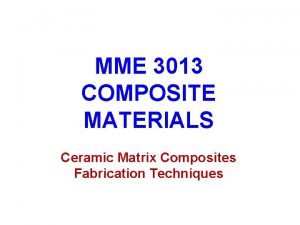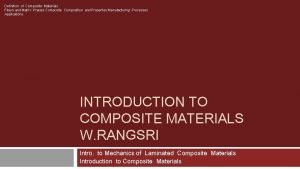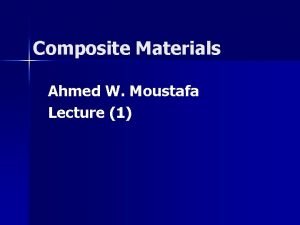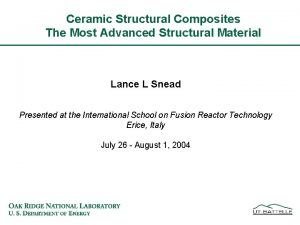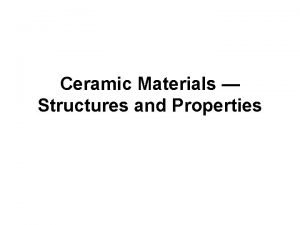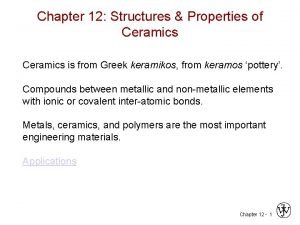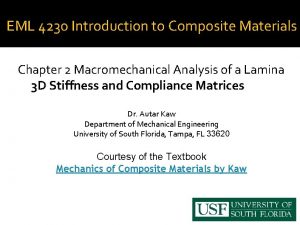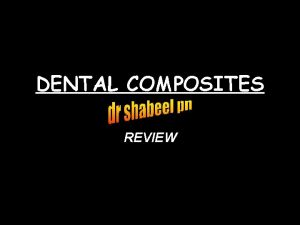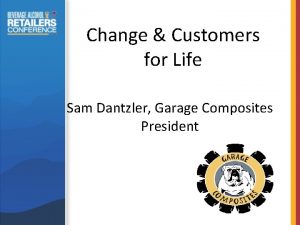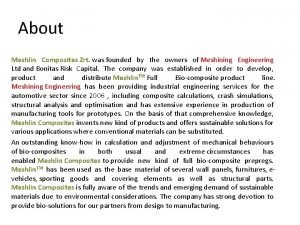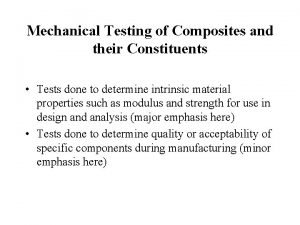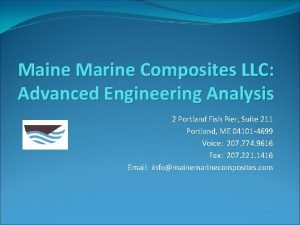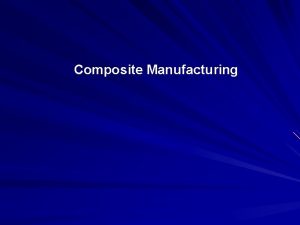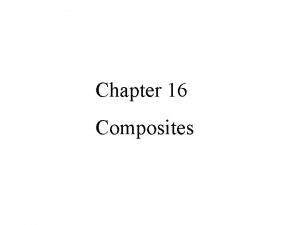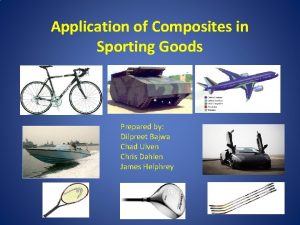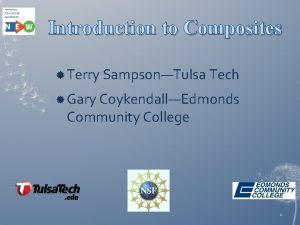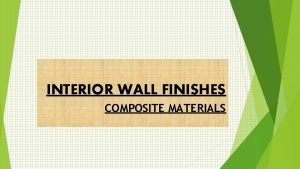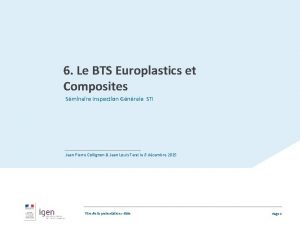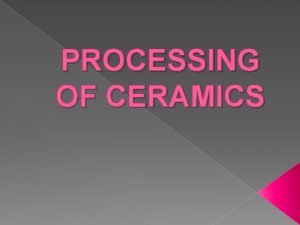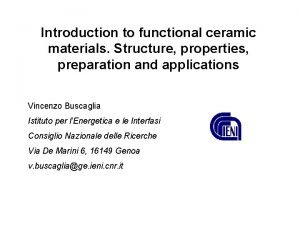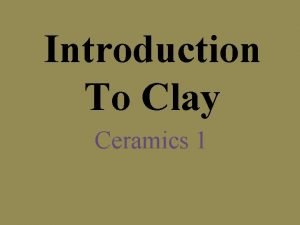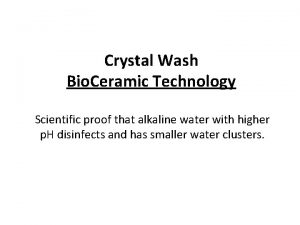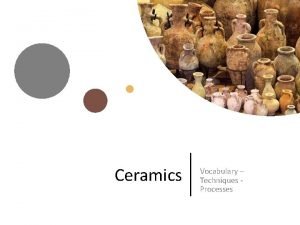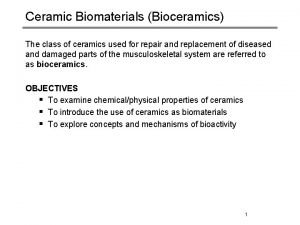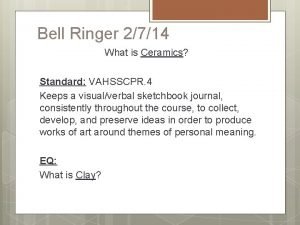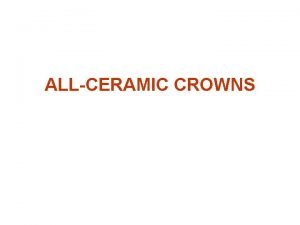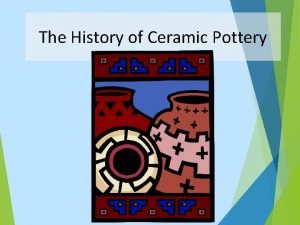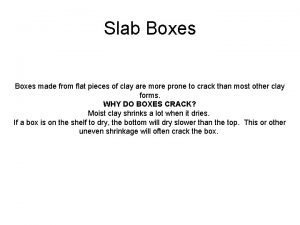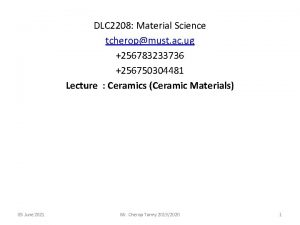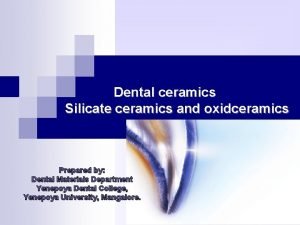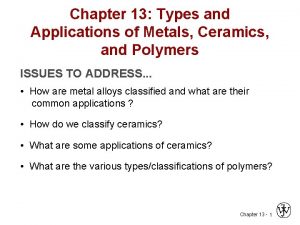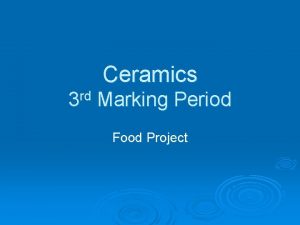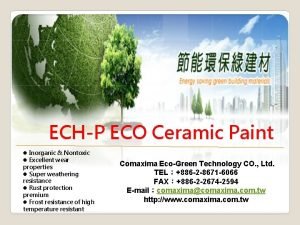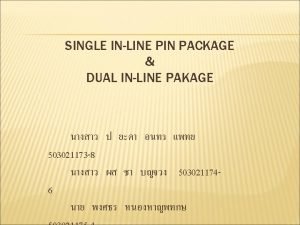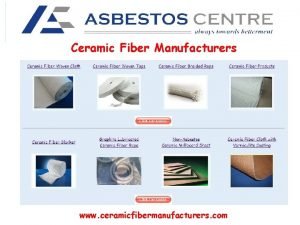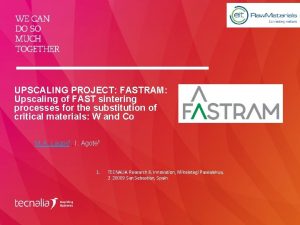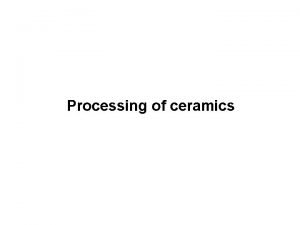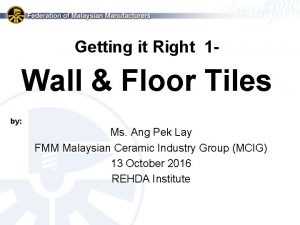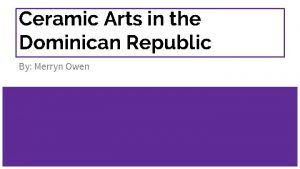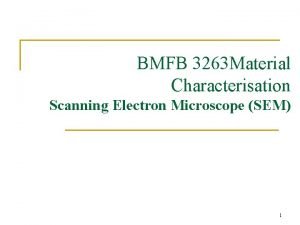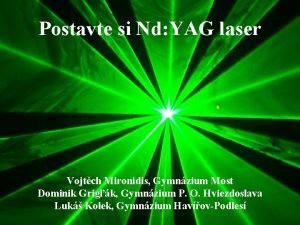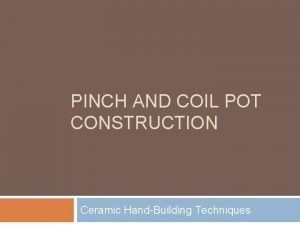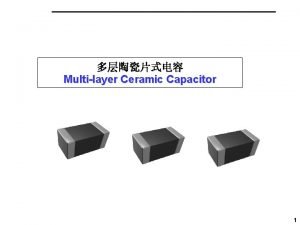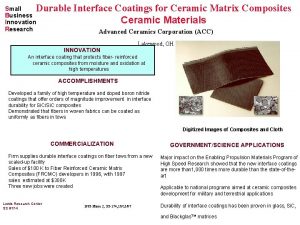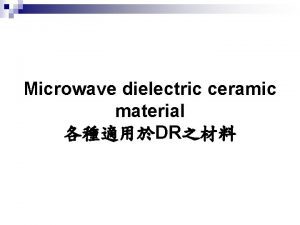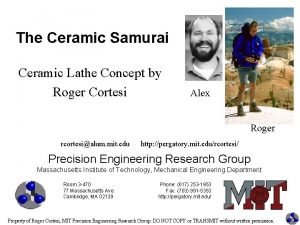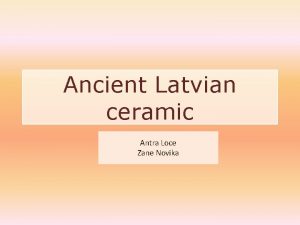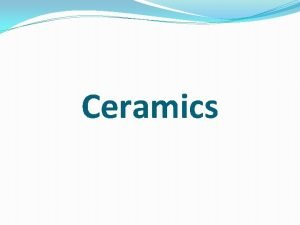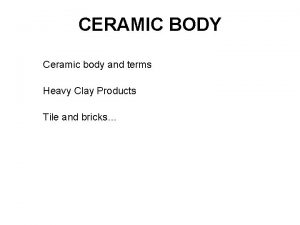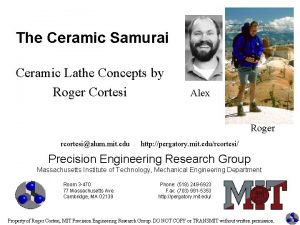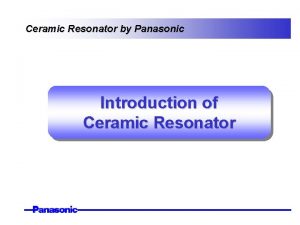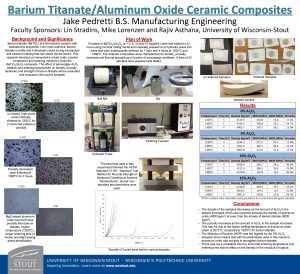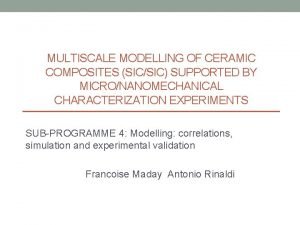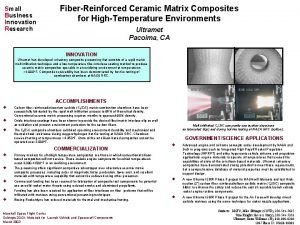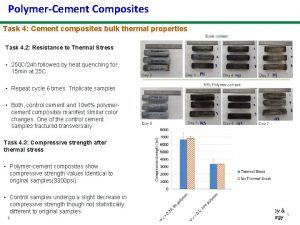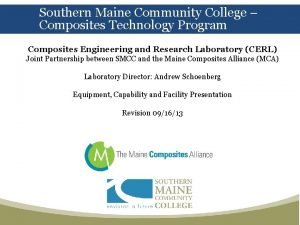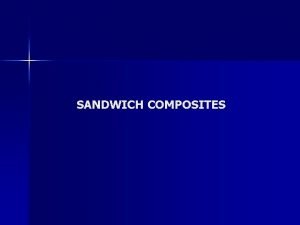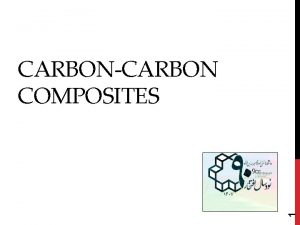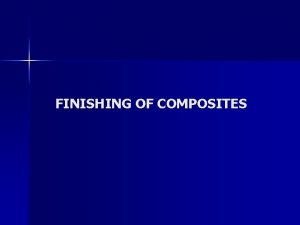Ceramic Structural Composites The Most Advanced Structural Material

























































- Slides: 57

Ceramic Structural Composites The Most Advanced Structural Material Lance L Snead Presented at the International School on Fusion Reactor Technology Erice, Italy July 26 - August 1, 2004

Composite -v- Monolithic Ceramics Interphase fiber matrix LOAD crack arrest Matrix Fiber Composite materials, whether platelet, chopped fiber, or continuous fiber reinforced are superior “engineering”materials to monolithics: • generally higher strength, especially in tension • higher Weibull modulus (more uniform failure) • much higher damage tolerance (fracture toughness)

Composite -v- Monolithic Ceramics Toughness MPa/m-1/2 Steel >50 Monolithic Ceramic 3 Platelet Reinforced Ceramic 6 Chopped Fiber Reinforced 10 Continuous Fiber Reinforced Ceramic 25 -30 Monolithic Strength (MPa) Composite Strength (MPa) Si. C 100 ± 50 220 ± 20 Graphite 107 ± 20 176 ± 20

Ceramic Structural Composites The Most Advanced Structural Material Composite Examples

Structural Composites in Aerospace Applications • Thermal protection system for a re-entry space vehicle: Nose corn, leading edge, … • Rocket engine: Extendable nozzle, aerospike engine, … • Scram-jet engine for a future space vehicle. C/C with TBC/EBC is in commercial. Si. C/Si. C will be more attractive (e. g. Tyrannohex).

Exhaust Tail-cone Weaving / 2 D Cloth + Stitching Successfully engine demonstrated at gas temperature 1573 K (1998)

Si. C/Si. C Thrust chamber Weaving / 3 -Axial Braiding Successfully hot firing tested at gas temperature 2073 K (1998)

Carbon Fiber Reinforced Composites TREK Madone 5. 9 Carbon Fiber Composite

Glass Fiber Reinforced Composites Ferrari 308 GT 4 Glass Fiber Composite

Reinforced Concrete Composite Steel reinforced “rebar” Carbon Fiber/epoxy rod

Reinforced Fired Adobe Composite

Reinforced Fired Adobe Composite Inca city ~ 1500 AD Present Day

Reinforced Fired Adobe Composite Inca city ~ 1500 AD fiber crack matrix LOAD crack arrest Present Day

Puye Cliff Dwelling Anasaze Indians 1100 -1580 AD

Fort Paramonga Chimu civilization ~1300 AD

Tel-Dan Arch ~1600 BC

Short History of Materials Relative Importance 10000 bc 5000 bc 0 1000 1500 1600 GOLD COPPER BRONZE IRON 1900 1940 1980 ODS STEELS LIGHT ALLOYS RUBBER HORSEHAIR PLASTER CEMENT 5000 bc HIGH TEMPERATURE POLYMERS BAKELITE NYLON P. E. POTTERY GLASS PMMA REFRACTORIES PORTLAND CEMENT FUSED SILICA 0 1000 1500 1600 GLASSY METALS TITANIUM, ZIRCONIUM etc. ALLOYS COMPOSITES CERAMICS/ GLASSES NEW SUPERALLOYS SUPER ALLOYS GLUES STONE FLINT 2000 CAST IRON STEELS WOOD SKIN FIBERS STRAW-BRICK 1990 METALS POLYMERS/ ELASTOMER 10000 bc 1960 1900 HIGH MODULUS POLYMERS CERAMIC POLYESTERS MATRIX EPOXIES METAL ACRYLICS MATRIX C/C GFRE PYROLITIC TOUGHENED CERMETS CERAMICS 1940 Date 1960 1980 1990 2000

Ceramic Structural Composites The Most Advanced Structural Material Fusion Structural Composites

Yield Strength of Various Structural Materials Si. C/Si. C

Operating Range, Highly Irradiated Structural Materials C/C Si. C/Si. C Tungsten Molybdenum ODS Ferritic F/M Steel 316 Stainless Alloy 718 Questionable Reasonable

Ceramic Structural Composites The Most Advanced Structural Material Carbon/Carbon Composites - In widespread structural use - Manufacturing and design methods understood - Expensive…

Divertor Designs Using C/C Composites Full-scale vertical target armored mock-up uses a pure Cu clad DS-Cu tube armored with saddle-block C/C and CVD-W armors. (Hitachi Ltd. , Japan) W C/C Pure Cu clad DS-Cu tube armored with C/C monoblocks. (Kawasaki Heavy Industries, Japan) C/C

Ceramic Structural Composites The Most Advanced Structural Material Irradiation Performance of Carbon Fiber Composites - Lifetime is limited - Tritium Retention Unavoidable

Graphite Under Irradiation H 451 Graphite

CFC’s Under Irradiation (HFIR , 600°C)

CFC’s Under Irradiation fiber Composite allows “engineering” of properties such as dimensional change gap 500°C ~ 10 dpa 800°C sample surface bundle swelling bundle shrinkage

gap bundle swelling bundle

CFC’s Under Irradiation : Tritium Retention • T-3 attaches to basal plane edges and highly defected structure. More perfect material and/or high temperature allows less retention. T-3 Retention (appm) 1000 100 Intermediate Quality Irradiated Graphite (Causey, Snead) High Quality Irradiated CFC (Causey, Snead) Non-irradiated, infinite charge time 10 Non-Irradiated 1 hr Charge Time 1 200 400 600 800 1000 1200 1400 Irradiation / T-3 Loading Temperature (C) NRL IFE 2/2001

Ceramic Structural Composites The Most Advanced Structural Material Si. C/Si. C Composites - Essentially no current structural application - Manufacturing and design methods immature

ARIES-I – First Blanket Design Using Si. C/Si. C • Excellent safety & environmental characteristics (very low activation and very low afterheat). • High performance due to high strength at high temperatures (>1000ºC).

ARIES-AT – Liquid Wall Blanket Concept (USA) • Simple, low pressure design with Si. C structure and self-cooled Pb-17 Li breeder. • High Pb-17 Li outlet temperature (~1100ºC) and high thermal efficiency of 58. 5%. - Max Si. C/Si. C temp. : 996ºC. - Max Si. C/Si. C-coolant (Pb-17 Li) interface temp. : 900 -940ºC. • Simple manufacturing technique. • Very low afterheat. • Class C waste by a wide margin.

TAURO – Si. C/Si. C Blanket Design in EU • Self-cooled Pb-17 Li breeder and n multiplier. • Pb-17 Li inlet/outlet temperature (650/860ºC). - Max Si. C/Si. C temp. : 995ºC. - Max Si. C/Si. C-coolant (Pb-17 Li) interface temp. : 915ºC. • Simple manufacturing technique (based on joining of panels/tubes by brazing). • The maximum shear in the joints is 60 MPa. • 6 mm thickness as first wall to deal with thermomechanical loads. • Brayton cycle thermal efficiency: >47%.


Ceramic Structural Composites The Most Advanced Structural Material Si. C/Si. C Composites Under Irradiation - May survive for life of machine - Thermal conductivity is likely less than assumed - Electrical conductivity appears not to be a problem

Si. C Under Irradiation • Irradiation-induced thermo-physical property changes (swelling, thermal conductivity, strength) saturate by a few dpa for T< 1000°C. Driven by simple defect clusters. • Irradiation performance for T>1000°C is not well understood.

Silicon Carbide Under Irradiation • Irradiation-induced thermo-physical property changes (swelling, thermal conductivity, strength) saturate by a few dpa for T< 1000°C. Driven by simple defect clusters. • Irradiation performance for T>1000°C is not well understood.

Si. C/Si. C Composites : Strength and Stability Until recently, Si. C/Si. C composites exhibited significant degradation in mechanical properties due to non-Si. C impurities in fibers causing interfacial debonding. Bulk Si. C-interlayer Thin C-interlayer Si. C-interlayer Ceramic fiber 0. 5 m Si. C multilayers Si. C fiber 300 nm Upon irradiation, if fibers densify, fiber/matrix interfaces debonds -->strength degrades

Si. C/Si. C Composites : Strength and Stability Bend strength of irradiated “advanced” composites show no degradation up to 10 dpa 1 st- and 2 nd generation irradiated Si. C/Si. C composites show large strength loss after doses >1 dpa

Si. C/Si. C Composites : Thermal Conductivity CVD Si. C Irradiated

Thermal Defect Resistance Si. C/Si. C Composites : Thermal Conductivity Umklapp radiation defects intrinsic defects boundaries umklapp

Si. C/Si. C Composites : Thermal Conductivity Data for an “ideal” Si. C Thermal conductivity reduction is due to simple vacancies and vacancy clusters. This is a strict material property which can not be improved upon.

Si. C/Si. C Composites : Thermal Conductivity Umklapp (phonon boundaries Scattering) intrinsic defects radiation defects

Si. C/Si. C Composites : Thermal Conductivity x=goal Umklapp (phonon boundaries Scattering) intrinsic defects radiation defects

Si. C/Si. C Composites : Thermal Conductivity Due to “interfaces” and cracks in Si. C composite, thermal conductiivity will necessarily be less than ideal Si. C. Present materials are significanlty lower than ~15 W/m-K reactor study goal.

Composite Comparison for FISSION (at 1000°C) * does not include prototyping or NDE evaluation.

Ceramic Structural Composites The Most Advanced Structural Material Si. C Matrix / Graphite Fiber Composites - Now being used in NASA application - Manufacturing and design methods immature - May solve the dual problems of low thermal conductivity of Si. C/Si. C and high T-3 retention of C/C

Argument #1: Strength (& toughness) as good or superior to Si. C/Si. C Tensile Strength (MPa) Si. C/Si. C Composite (2 -D lay-up) Si. C/graphite Composite (2 -D lay-up)

Argument #2: Reduced tritium retention over best C/C’s Tirr=600°C Tload=1000°C l sa Ba d ge ce Ed du e Re Plan Tritium retention, nonirradiated and irradiated, is highly dependent on graphite perfection. K-1100 type fibers are nearly perfect. Si. C has very low tritium retention.

Argument #2: Reduced tritium retention over best CFC’s Intermediate Quality Graphite • By replacing the lower perfection matrix of CFC’s with Si. C, Si. C/graphite will have lower retention. High Quality Graphite Fiber Composite Tirr=200°C Tload=1000°C

Argument #3: Significant thermal conductivity enhancement Defect Resistance

Engineered High Thermal Conductivity Si. C/G Composite • Matrix : CVI Si. C , no interphase • Fibers : Z-direction either Amoco P 55 or Thornel K-1100 fiber X-Y direction Amoco P-55 fiber. Total Volume Fraction 44%. • Architecture: Unbalanced 1 -1 -6 weave. High TC K 1100 fiber

Si. C Matrix / Graphite Fiber Composites • �At fusion-relevant Si. C/g: temp. , --> conductivity exceeds present Si. C/Si. C --> conductivity exceeds Si. C theoretical max. --> Low TC direction on order of Si. C/Si. C thermal conductivity (for this composite).

Si. C Matrix / Graphite Fiber Composites • �At fusion-relevant temperature, Si. C/g exceeds theoretical maximum of Si. C/Si. C

Summary • Fiber reinforced composites are arguably the oldest man-made structural material. However, because predictive design tool (codes) have been based on metallic design over the past century structural design with composites is currently impractical. Design is based on prototyping, not modeling…. • Carbon fiber composite manufacturing and application is fairly mature, however lifetime of composite structures is strictly defined to ~ 15 dpa, or a year in a fusion reactor. Tritium retention in CFC’s can be reduced, but never eliminated. • Si. C/Si. C composite offer the possibility of lifetime components, but asirradiated thermal conductivity will almost certainly be less than the 15 W/m-K assumed in present studies.

Questions ? ? ? Questions ?

Fabrication of C/C Composites Carbon Fiber: • PAN (polyacrylonitrile) based carbon fiber - Commercial use for general purpose. - Varieties: high strength, high modulus, long elongation, … • Pitch based carbon fiber - High performance carbon fiber: Anisotropic, high graphitization. Tensile strength: 2. 3~4. 0 GPa, Tensile modulus: 400~900 GPa - General purpose (low cost) carbon fiber: Isotropic microstructure. Tensile strength: 0. 6~1. 0 GPa, Tensile modulus: 30~60 GPa Carbon Matrix: • Chemical vapor deposition (CVD) • Impregnation and pyrolysis using resin or pitch. Environmental Barrier Coating: Concern about high reactivity to oxidative products. • Boron based glasses (<1000ºC) • Silicon carbide (<1500ºC) carbon Temperature graphite “Graphitization”

Key Characteristics of Si. C(-based) Fibers
 Ceramic matrix composites definition
Ceramic matrix composites definition Composite material definition
Composite material definition Ceramic matrix composites definition
Ceramic matrix composites definition Structural composites industries llc
Structural composites industries llc Ceramic material structure
Ceramic material structure Rcation/ranion
Rcation/ranion Orthotropic compliance matrix
Orthotropic compliance matrix Composites and components ofsted
Composites and components ofsted Composite chemistry definition
Composite chemistry definition Garage composites
Garage composites Esz zrt
Esz zrt Mechanical materials
Mechanical materials Maine marine composites
Maine marine composites Advantages and disadvantages of thermoplastics
Advantages and disadvantages of thermoplastics Matrix materials zrt
Matrix materials zrt Composites in sports
Composites in sports Warp clock composites
Warp clock composites What are composites
What are composites Bts europlastics et composites
Bts europlastics et composites Evidence testimony
Evidence testimony What is ceramic
What is ceramic Greek beads keramos
Greek beads keramos What is ceramic made of
What is ceramic made of Ceramic semiconductor thermometer
Ceramic semiconductor thermometer Bio ceramic technology
Bio ceramic technology Scoring definition ceramics
Scoring definition ceramics Disadvantages of bioceramics
Disadvantages of bioceramics What is this
What is this Porcelain jacket crown indications
Porcelain jacket crown indications Pottery history timeline
Pottery history timeline Clay slab box
Clay slab box Fractional distillation of petroleum
Fractional distillation of petroleum Ceramic classification
Ceramic classification Silicate ceramics dentistry
Silicate ceramics dentistry Die blanks ceramics
Die blanks ceramics Ceramic food project
Ceramic food project Vacuum casting advantages and disadvantages
Vacuum casting advantages and disadvantages Non toxic ceramic paint
Non toxic ceramic paint Dual inline package use
Dual inline package use Ceramic fiber manufacturers
Ceramic fiber manufacturers Ceramic processing upscaling
Ceramic processing upscaling Ceramic processing upscaling
Ceramic processing upscaling Ceramic tile classification
Ceramic tile classification Dominican faceless ceramic dolls
Dominican faceless ceramic dolls Sem
Sem Yag ceramic
Yag ceramic Intrinsic semiconductor
Intrinsic semiconductor Coil construction ceramics
Coil construction ceramics Multilayer ceramic capacitor
Multilayer ceramic capacitor Virtual condition in gd&t
Virtual condition in gd&t Material yield variance arises due to change in the
Material yield variance arises due to change in the Time space compression ap human geography
Time space compression ap human geography Material and non material culture examples
Material and non material culture examples Material and non material culture examples
Material and non material culture examples Useful materials at home and ways to use
Useful materials at home and ways to use Nervous system guided notes
Nervous system guided notes Hình ảnh bộ gõ cơ thể búng tay
Hình ảnh bộ gõ cơ thể búng tay Slidetodoc
Slidetodoc
